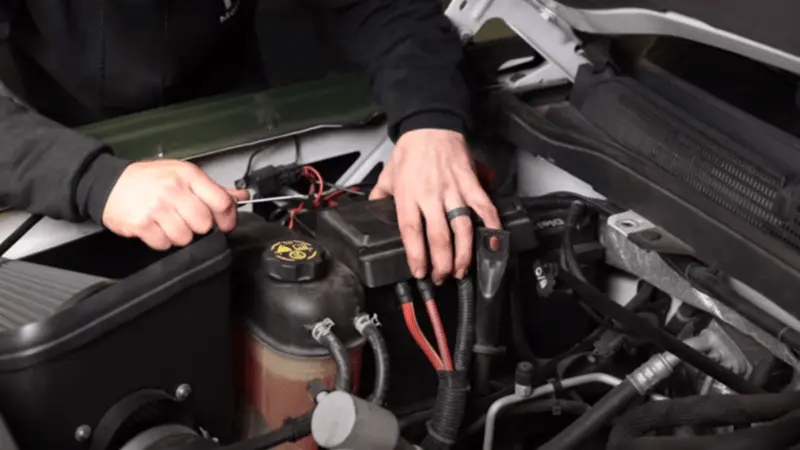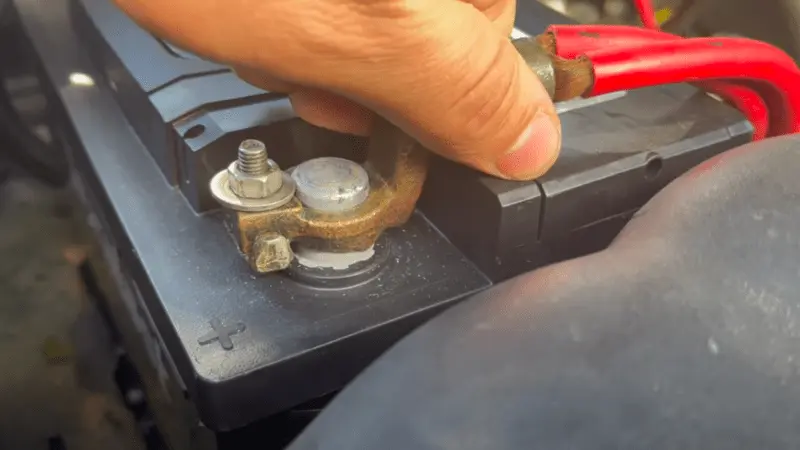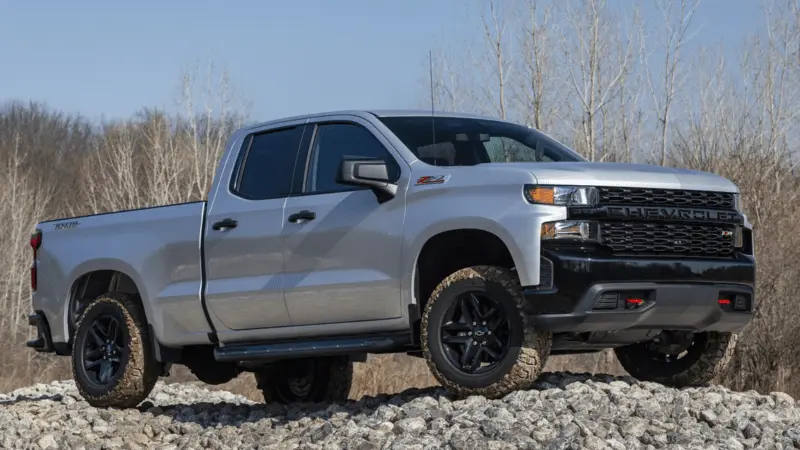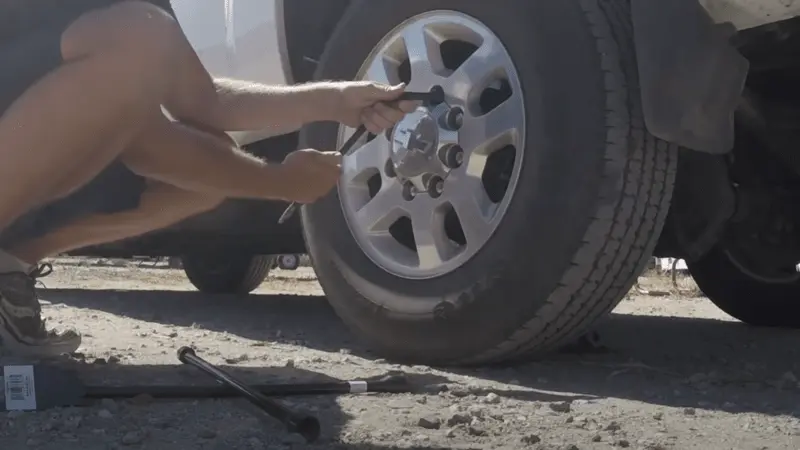Few things are as perplexing and frustrating as the moment you turn the key to start your trusty Chevy Silverado and nothing. A new battery should mean worry-free starts, but sometimes, even with fresh power, the Chevy Silverado won’t start after new battery. Why?
Well, A new battery typically promises smooth starts, yet Chevy Silverado owners may encounter a non-starting conundrum even with fresh power. Discovering the reasons behind this unexpected hiccup can save the day and ensure your Silverado is ready to hit the road.
Join us in finding the possible reasons and practical solutions to revive your trusty companion. Your solution may be just a few insights away.
| Reasons | Solutions |
|---|---|
| Security System Reset | Key reset procedure or professional assistance |
| Key Fob Programming | Manual reprogramming or professional assistance |
| Faulty Starter | Starter replacement or solenoid check |
| Ignition Switch Issues | Key and switch inspection, ignition switch replacement |
| Alternator Problems | Check charging voltage, belt and wiring inspection, professional evaluation, alternator replacement |
| Battery Cables | Visual inspection, cleaning and tightening, cable replacement, professional assessment |
| Fuel Delivery Issues | Fuel pump assessment, fuel filter inspection, professional diagnosis, regular maintenance |
| Faulty Sensors | Diagnostic scan, sensor replacement, wiring and connection check, regular maintenance |
Reasons & Solutions Of Chevy Silverado Won’t Start After New Battery

Ignition Switch Issues:
Issue: If your Chevy Silverado is not starting even with a new battery, it might be due to a malfunctioning ignition switch. The ignition switch is a critical component that initiates the starting process by sending an electrical signal to the starter motor. When it fails, the vehicle may not respond when you turn the key.
Solution:
- Key and Switch Inspection: Begin by ensuring that the key itself is not damaged or worn out. Sometimes, a damaged key can cause ignition issues. If the key appears fine, then the ignition switch itself should be inspected.
- Ignition Switch Replacement: If the ignition switch is found to be faulty, it will need to be replaced. This is a complex task that typically requires the expertise of a professional mechanic. They will need to disassemble the steering column to access and replace the ignition switch.
- Starter and Solenoid Check: Before replacing the ignition switch, it’s a good idea to ensure that the issue is not with the starter or solenoid. A mechanic can perform tests to rule out these components as potential causes of the no-start condition.
- Professional Assistance: Ignition switch replacement is best left to professionals due to the complexity of the task and the need for specialized tools. A certified mechanic can accurately diagnose the issue and replace the switch, ensuring your vehicle starts reliably.
RELATED: Key Stuck in Ignition Chevy Dead Battery
Security System Reset:
Issue: When a new battery is installed in a Chevy Silverado, the vehicle’s security system may be triggered, leading to a temporary lockout. This occurs because the security system may not recognize the new power source, causing it to immobilize the vehicle.
Solution:
To resolve this issue, follow these steps:
- Key Reset Procedure: Insert the key into the driver’s side door lock and turn it to the unlock position, then lock it back. Repeat this process three times. This can reset the security system and allow the vehicle to start.
- Use a Scan Tool: A more advanced method involves using a scan tool to reset the security system. A professional mechanic typically performs this, and it may be necessary if the key reset procedure doesn’t work.
Alternator Problems:

Issue: If your Chevy Silverado doesn’t start after installing a new battery, one potential culprit could be a malfunctioning alternator. The alternator is responsible for charging the battery while the engine is running. If it fails to do so, your vehicle may not start, even with a new battery.
Solution:
- Check Charging Voltage: You can start by checking the voltage across the battery terminals with the engine running. The voltage should typically read between 13.5 and 14.5 volts, indicating that the alternator is charging the battery. If the voltage is significantly lower or higher, it may indicate an alternator problem.
- Belt and Wiring Inspection: Ensure that the alternator belt is properly tensioned and in good condition. Loose or damaged belts can affect the alternator’s operation. Additionally, inspect the wiring and connections around the alternator to confirm they are secure and free from corrosion.
- Professional Evaluation: If you suspect an alternator problem, it’s advisable to have a professional mechanic perform a more comprehensive evaluation. They can use specialized tools to diagnose the alternator’s performance accurately.
- Alternator Replacement: If the alternator is found to be faulty, it will need to be replaced. Replacing an alternator is a complex task best handled by a professional mechanic who can ensure that the new alternator is correctly installed and functioning.
Key Fob Programming:
Issue: When installing a new battery in your Chevy Silverado, the key fob may lose its programming or synchronization with the vehicle.
Solution:
- Manual Reprogramming: In most cases, you can manually reprogram the key fob. To do this, you’ll need to follow specific steps outlined in your vehicle’s owner’s manual. Typically, this involves pressing certain buttons on the key fob in a particular sequence while in the vehicle.
- Professional Assistance: If manual reprogramming doesn’t work, consider seeking help from a dealership or a professional automotive locksmith. They have specialized tools and knowledge to reprogram the key fob accurately.
Battery Cables:

Issue: In the event of a new battery installation, your Chevy Silverado may still experience starting issues due to loose or corroded battery cables. Battery cables are vital for transferring power from the battery to the vehicle’s electrical system. If they are loose or corroded, it can disrupt the power flow required to start the engine.
Solution:
- Visual Inspection: Start by visually inspecting the battery cables. Look for signs of corrosion, which often appear as a white or greenish substance on the cable connections. Additionally, check the cable connections to ensure they are securely attached to the battery terminals.
- Cleaning and Tightening: If you find corrosion, it’s essential to clean the affected areas. Use a mixture of baking soda and water, along with a wire brush, to scrub away the corrosion. After cleaning, make sure to tighten the cable connections to the battery terminals securely.
- Replacement: In cases where the cables are severely corroded, damaged, or worn, it might be necessary to replace them. Ensure that you choose the appropriate replacement cables for your specific vehicle model.
- Professional Assessment: If you need more certainty about the condition of your battery cables or need more tools and experience to address the issue, it’s advisable to consult a professional mechanic. They can perform a thorough inspection and handle cleaning, tightening, or replacement as needed.
Faulty Starter:
Issue: Even with a new battery, an old or malfunctioning starter may not engage properly, preventing the vehicle from starting.
Solution:
- Starter Replacement: If the starter is the issue, it will likely need replacement. Consult a mechanic to diagnose the problem accurately and install a new starter if necessary.
- Solenoid Check: Sometimes, the starter issue is related to the solenoid rather than the entire starter motor. A mechanic can check and replace the solenoid if needed, which can be a more cost-effective solution.
Fuel Delivery Issues:
Issue: If your Chevy Silverado experiences difficulties starting, even with a new battery, it might be attributed to problems with fuel delivery. Fuel delivery issues can include a faulty fuel pump or a clogged fuel filter, which can disrupt the flow of gasoline to the engine, preventing it from starting.
Solution:
- Fuel Pump Assessment: To determine if the fuel pump is causing the problem, listen for a faint humming sound from the fuel tank area when you turn the ignition key to the “On” position. If you don’t hear this sound, it may indicate a faulty fuel pump. A professional mechanic can perform a fuel pressure test to verify the pump’s functionality.
- Fuel Filter Inspection: The fuel filter’s purpose is to screen out impurities from the gasoline. If it becomes clogged, it can limit the flow of fuel to the engine. Consider inspecting and potentially replacing the fuel filter as part of your maintenance routine, especially if you suspect it might be the cause of the starting issue.
- Professional Diagnosis: If you need more certainty about the problem or need more tools and expertise, it’s advisable to consult a professional mechanic. They can assess the fuel system comprehensively, ensuring that the fuel pump and filter are functioning correctly.
- Regular Maintenance: To prevent fuel delivery issues in the future, follow the manufacturer’s recommendations for regular maintenance, which includes changing the fuel filter at specified intervals.
Faulty Sensors:
Issue: One of the less common but critical issues that can lead to starting problems in your Chevy Silverado is the malfunction of sensors, particularly the crankshaft position sensor. These sensors play a crucial role in relaying information to the engine control module (ECM), affecting ignition timing and fuel injection. When sensors malfunction, it can disrupt these critical processes, preventing the engine from starting.
Solution:
- Diagnostic Scan: To identify sensor-related problems, a diagnostic scan with a specialized tool is necessary. This scan will detect any error codes related to sensor malfunctions. If specific sensors, like the crankshaft position sensor, are indicated as problematic, they will need replacement.
- Sensor Replacement: Malfunctioning sensors, once identified, should be replaced promptly. A professional mechanic should carry out sensor replacement with experience in handling engine sensors, as it requires precision and expertise.
- Wiring and Connection Check: Sometimes, sensor issues are not with the sensors themselves but with the wiring and connections associated with them. A thorough check of these components may reveal loose or damaged connections that can be repaired or replaced.
- Regular Maintenance: To prevent sensor issues in the future, it’s important to adhere to your vehicle’s maintenance schedule. This includes periodic checks of sensors and their associated components.
Advice on How to Take Care of Your Chevrolet Silverado

Taking care of your Chevrolet Silverado is essential to ensure its longevity, performance, and overall well-being. Whether you use it for work, play, or daily commuting, proper maintenance is key. Here are eight pieces of advice to help you keep your Silverado in excellent condition:
Regular Maintenance:
Keep up with your Silverado’s scheduled maintenance as outlined in the owner’s manual. This includes oil changes, filter replacements, brake inspections, and more. Regular maintenance ensures that your vehicle’s components function optimally.
Check Fluids:
Regularly inspect and top off essential fluids like engine oil, transmission fluid, coolant, and brake fluid. Proper fluid levels and quality are critical for your Silverado’s engine and other systems.
Tire Care:
Check tire pressure regularly and ensure that they are properly aligned. Proper tire maintenance improves fuel efficiency, handling, and tire life. Remember to rotate your tires as recommended.

Keep It Clean:
Regularly wash your Silverado to prevent rust and maintain its appearance. Pay attention to the undercarriage and wheel wells, where dirt and salt can accumulate.
Protect the Interior:
Invest in quality seat covers, floor mats, and steering wheel covers to protect your interior from wear and tear. Regularly clean and condition leather or fabric seats to maintain their appearance.
Secure Your Cargo:
If you use your Silverado for hauling, invest in bed liners and cargo tie-downs. These protect the bed and ensure your cargo remains secure.
Stay Organized:
Keep your vehicle organized and clutter-free. This not only enhances comfort but also minimizes the potential for damage to the interior during sudden stops or turns.
Drive Mindfully:
Drive your Silverado responsibly. Avoid aggressive acceleration, abrupt stops, and high-speed turns, which can strain the vehicle and reduce fuel efficiency. Mindful driving also reduces the risk of accidents.
Garage or Shelter:
If possible, park your Silverado in a garage or under a shelter to protect it from harsh weather, including sun, rain, snow, and hail. This helps maintain the exterior finish and prolongs the life of various components.
Emergency Kit:
Always keep an emergency kit in your Silverado. This should include basic tools, jumper cables, a flashlight, first-aid supplies, and essential items for your safety and convenience in case of roadside issues.
SEE MORE: Chevy Silverado Shuts Off While Driving And Won’t Start
Frequently Asked Questions
1. How Can I Tell If My New Battery Is Faulty?
Ensure the battery is correctly connected and fully charged. If your Silverado still doesn’t start, have the battery tested to confirm its condition.
2. Can A Loose Or Corroded Battery Cable Prevent A New Battery From Starting The Vehicle?
Yes, loose or corroded battery cables can disrupt power flow. Regularly inspect and clean cable connections to ensure a secure connection.
3. What If My Silverado’s Starting Issues Persist After Addressing Common Solutions?
If the problem persists, consult a professional mechanic for a comprehensive diagnosis. There may be underlying issues that require expert attention.
4. Can Extreme Weather Conditions Affect My Silverado’s Ability To Start With A New Battery?
Yes, extreme cold or hot weather can impact a battery’s performance. Extremely cold temperatures can reduce the battery’s cranking power, while extreme heat can lead to battery fluid evaporation. It’s important to monitor and maintain your battery in such conditions.
5. What Role Does The Alternator Play In Starting Issues, Even With A New Battery?
The alternator is responsible for charging the battery while the engine is running. If the alternator is faulty and doesn’t charge the new battery, it may lead to starting problems. Ensure the alternator is functioning correctly to avoid these issues.
Final Discussion
In the world of automotive conundrums, few scenarios can be as puzzling as a vehicle that won’t start, especially after fitting it with a brand-new battery. This blog post has unraveled the mystery behind this issue, offering insights into security system resets, key fob programming, starter troubles, and other common culprits.
By understanding these potential challenges and their solutions, you’ll be better equipped to tackle the situation head-on, ensuring that your Silverado roars to life with confidence. Remember, with a little diagnostic finesse and a touch of expert advice, your trusty Silverado can be back on the road, ready to conquer your journeys once more.

Eric L. Friedman is a car expert who has worked on Chevy and GMC trucks for over 10 years. He started AutoYolo to help people fix their own cars. On the blog, he shares easy tips, step-by-step guides, and repair advice to make car problems less stressful and more affordable.

